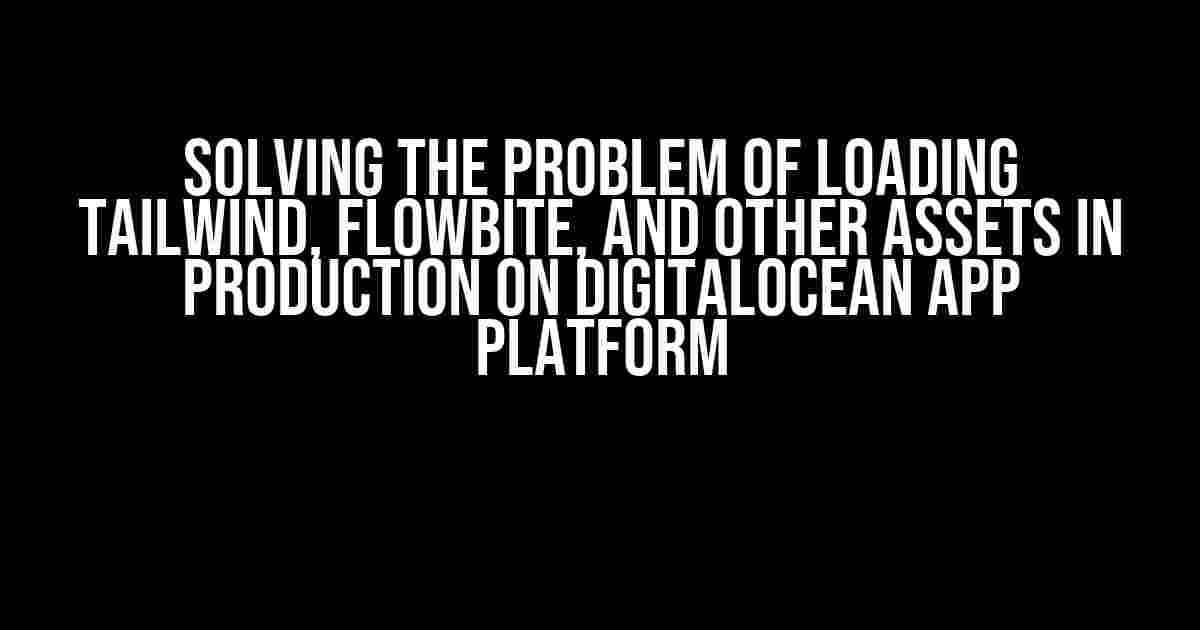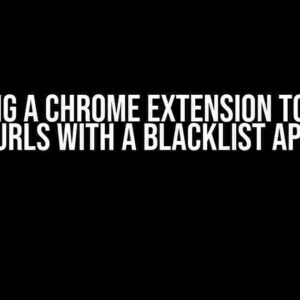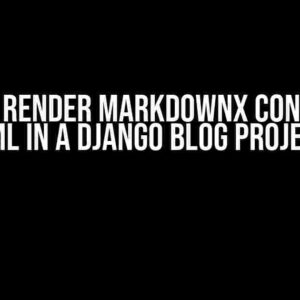Are you tired of banging your head against the wall, trying to figure out why your Tailwind CSS, Flowbite, and other assets refuse to load in production on DigitalOcean App Platform? Well, you’re in luck! This article is here to guide you through the troubleshooting process and provide you with solutions to get your assets loading smoothly.
- Understanding the Problem
- Verifying the Issue
- Solution 1: Update Your `package.json` File
- Solution 2: Configure Your `nginx.conf` File
- Solution 3: Use a CDN or Asset Server
- Solution 4: Use a Build Tool like Webpack or Rollup
- Solution 5: Check Your File Permissions
- Solution 6: Check Your Browser Cache
- Conclusion
Understanding the Problem
Before we dive into the solutions, let’s take a step back and understand the problem. When you deploy your application on DigitalOcean App Platform, it uses a unique file system and caching mechanism. This can sometimes cause issues with loading assets like Tailwind CSS, Flowbite, and other third-party libraries.
The problem arises when your application tries to access these assets, but they’re not being served correctly. This can lead to errors, broken layouts, and a overall poor user experience.
Verifying the Issue
To verify that the issue is indeed related to asset loading, follow these steps:
- Check your application’s error logs for any errors related to asset loading.
- Inspect the network requests in your browser’s developer tools to see if the assets are being requested but not loaded.
- Verify that the assets are present in your repository and correctly referenced in your code.
Solution 1: Update Your `package.json` File
In some cases, the issue can be resolved by simply updating your `package.json` file to include the correct script for building and serving your assets.
"scripts": {
"build": "npm run build:tailwind && npm run build:flowbite",
"build:tailwind": "npx tailwindcss -i ./src/styles.tailwind.css -o ./public/styles.css",
"build:flowbite": "npx flowbite -i ./src/styles.flowbite.css -o ./public/styles.flowbite.css"
}
Make sure to update your `package.json` file to include the correct scripts for building and serving your assets.
Solution 2: Configure Your `nginx.conf` File
If updating your `package.json` file doesn’t resolve the issue, you may need to configure your `nginx.conf` file to serve your assets correctly.
server {
listen 80;
server_name example.com;
location / {
proxy_pass http://localhost:3000;
proxy_http_version 1.1;
proxy_set_header Upgrade $http_upgrade;
proxy_set_header Connection 'upgrade';
proxy_set_header Host $host;
proxy_cache_bypass $http_upgrade;
}
location ~* \.(css|js|jpg|png|gif|woff|woff2|eot|ttf|svg)$ {
root /app/public;
access_log off;
log_not_found off;
add_header Cache-Control "public, max-age=31536000";
}
}
In this configuration, we’re telling Nginx to serve your assets from the `/app/public` directory. Make sure to update the `root` directive to match your application’s directory structure.
Solution 3: Use a CDN or Asset Server
If the above solutions don’t work, you may need to consider using a CDN or asset server to serve your assets.
A CDN (Content Delivery Network) can help distribute your assets across multiple servers, reducing the load on your application and improving performance.
An asset server, on the other hand, can help serve your assets directly, bypassing the need for Nginx or other reverse proxies.
Some popular CDNs and asset servers include:
- Cloudflare
- Amazon S3
- Google Cloud CDN
- Microsoft Azure CDN
Solution 4: Use a Build Tool like Webpack or Rollup
If you’re using a build tool like Webpack or Rollup, you may need to configure it to output your assets in a way that’s compatible with DigitalOcean App Platform.
For example, you can use Webpack’s `output` configuration to specify the directory where your assets should be output:
module.exports = {
// ...
output: {
path: '/app/public',
filename: '[name].js',
chunkFilename: '[name].chunk.js'
}
};
In this example, we’re telling Webpack to output our assets to the `/app/public` directory.
Solution 5: Check Your File Permissions
Sometimes, the issue can be as simple as file permissions. Make sure that your application has the correct permissions to read and serve your assets.
You can check the file permissions using the `ls -l` command:
ls -l /app/public
If the permissions are incorrect, you can update them using the `chmod` command:
chmod -R 755 /app/public
Solution 6: Check Your Browser Cache
Yes, you read that right! Sometimes, the issue can be as simple as a browser cache issue.
Try clearing your browser cache and reloading your application to see if the issue resolves itself.
Conclusion
Loading Tailwind, Flowbite, and other assets in production on DigitalOcean App Platform can be a challenge, but it’s not impossible.
By following the solutions outlined in this article, you should be able to resolve the issue and get your assets loading smoothly.
Remember to take a step back, breathe, and approach the problem methodically. With patience and persistence, you’ll be able to troubleshoot and resolve the issue in no time!
| Solution | Description |
|---|---|
| Update `package.json` file | Update your `package.json` file to include the correct script for building and serving your assets. |
| Configure `nginx.conf` file | Configure your `nginx.conf` file to serve your assets correctly. |
| Use a CDN or asset server | Use a CDN or asset server to serve your assets directly. |
| Use a build tool like Webpack or Rollup | Configure your build tool to output your assets in a way that’s compatible with DigitalOcean App Platform. |
| Check file permissions | Check that your application has the correct permissions to read and serve your assets. |
| Check browser cache | Clear your browser cache and reload your application to see if the issue resolves itself. |
We hope this article has been helpful in resolving the issue of loading Tailwind, Flowbite, and other assets in production on DigitalOcean App Platform.
Remember to stay calm, stay patient, and keep troubleshooting until you resolve the issue!
Frequently Asked Question
Having trouble loading Tailwind, Flowbite, and other assets in production on Digital Ocean app platform? We’ve got you covered! Here are some frequently asked questions and answers to help you troubleshoot the issue:
Why are my assets not loading in production mode on Digital Ocean?
This is a common issue due to the way Digital Ocean handles static assets in production mode. By default, it serves static assets from a different URL than your development environment. To fix this, make sure to update your asset URLs to include the correct production URL.
How do I configure my Tailwind CSS to work with Digital Ocean’s production environment?
To configure Tailwind CSS for production on Digital Ocean, update your `tailwind.config.js` file to include the correct production URL. You can do this by setting the `publicPath` option to the correct production URL. For example: `publicPath: ‘/css’`. This will ensure that Tailwind generates the correct URLs for your CSS assets.
What about Flowbite? Do I need to make changes to its configuration as well?
Yes, Flowbite also requires configuration updates for production on Digital Ocean. Update your `flowbite.config.js` file to include the correct production URL. You can do this by setting the `assetsUrl` option to the correct production URL. For example: `assetsUrl: ‘/flowbite’`. This will ensure that Flowbite generates the correct URLs for its assets.
I’m still having issues with asset loading. What are some common mistakes to check for?
Common mistakes to check for include incorrect URL configurations, missed asset builds, and cache issues. Double-check your `tailwind.config.js` and `flowbite.config.js` files for correct URL configurations. Make sure to run `npm run build` or `yarn build` to ensure that your assets are built correctly. Finally, try clearing your browser cache and restarting your application to ensure that you’re serving the latest assets.
Where can I find more resources to help me troubleshoot asset loading issues on Digital Ocean?
For more resources, check out Digital Ocean’s official documentation on serving static assets, as well as the official Tailwind CSS and Flowbite documentation. You can also search for community forums and online tutorials that provide troubleshooting guides and solutions for similar issues.







